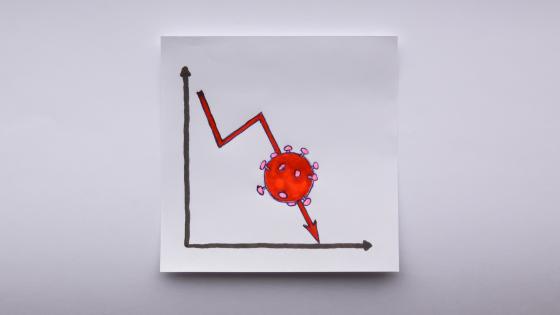The fast rebound of US stock prices following the Covid-19 shock has reignited discussions over ‘frothiness’ in stock markets. When compared to expected earnings, stock prices appear simply very high, painting a picture of overly optimistic investors. The risk is that currently high valuations might be baking a future stock market crash. High valuations, however, are not the outcome of exuberant stock investors pricing a fast recovery from the great lockdown. From a longer-term perspective, they appear to be the end-point of a more persistent trend. Annual data since 1880 suggest that the price dividend ratio has been trending upwards since the 1950s, with two sharp accelerations, one in the 1960s and one in the 1990s (Figure 1). Deciphering the underlying causes of this trend could shed some light on current stock market behaviour.
Figure 1 price dividend ratio since 1880.
Note: Price Dividend Ratio S&P500 (black) and estimated long-run component (green). Vertical shadows indicate recessions as identified by the National Bureau of Economic Research (NBER). Annual data for the Standard and Poor Composite Stock Price Index and associated dividends are sourced from Robert Shiller’s website, at http://www.econ.yale.edu/~shiller/data.htm.
Financial economics offers a simple framework to think about stock valuations. Movements in the price-dividend ratio fully reflect expected cash flows (i.e. dividend growth) or the expected return on stocks (Campbell and Shiller 1988). The higher the expected cash flows, the higher the stock prices are compared to current dividends. Expected return on stocks (the discount rate used by investors when discounting future cash flows) is instead inversely related to the price dividend ratio. Attractive valuations are incompatible with low expected returns, and (vice-versa) high valuations suggest that prices do not have much room left for further growth (meaning expected returns must be low).
The Campbell and Shiller (1988) decomposition could shed some light on the factors that have pushed stock valuations in the past 70 years, whether high expected dividend growth or low expected returns. This exercise, however, is less trivial than it might seem. In fact, it needs an econometric model that does two things at the same time: first, separating a trend component from transitory fluctuations, so as to filter out the expected components of dividend growth and stock returns from temporary shocks; second, imposing the exact decomposition of the price dividend ratio proposed by Campbell and Shiller (1988) on these two trends. In a recent paper (Delle Monache et al. 2020), we develop a new econometric methodology that is fit for this purpose, and use it to analyse the time-varying relationship between stock valuations, expected dividend growth, and expected returns in a long-run perspective.
We document that the secular rise in valuations is mainly due to lower expected stock returns, which have fallen from approximately 8% to 4% over the last 150 years (Figure 2, blue line). The long run growth of dividends has also fallen, but only mildly (from 2% to 1.5%, Figure 2 red line), and cannot account quantitatively for the rise in valuations. This result is fairly intuitive. In a world of secular stagnation, i.e. low growth and low rates, one would not expect dividend growth but rather low discount rates to raise stock prices. Our work provides an exact decomposition of the contribution of these two factors.
Figure 2 Long-run expected returns, expected dividend growth and price dividend ratio.
Note: Estimated long-run component of expected returns (blue) and dividend growth (red). Bands around the estimates correspond to the 68% confidence interval obtained through simulation. Vertical shadows indicate recessions as identified by the National Bureau of Economic Research (NBER).
But why have discount rates fallen so much? Stocks are valued like ‘bonds plus risk’. Hence, either the long-run expected return on bonds (a measure of ‘r-star’) has fallen, or risk appetite has increased. In our paper, we further delve into this question and use our methodology to decompose expected stock returns into a safe component and a long-run equity premium. We find that the former is mostly responsible for the rise in stock valuations. According to our analysis, r-star has fallen from around 3% in the 1950s to a current value of about 0.5% (Figure 3, blue line). It should be noted that these results are not distant from estimates of r-star obtained by Laubach and Williams (2003). The long-run equity premium, on the other hand, has remained roughly stable (Figure 3, red line). If anything, it has slightly risen after 2000, a result that is broadly consistent with the evidence in Farhi and Gourio (2018).
Our findings have important implications for interpreting current market conditions. First, our work confirms that discount rates, rather than dividend growth, need to take centre stage in the debate over stock prices (Cochrane 2011). Further, the behaviour of stock prices throughout the Covid-19 crisis is, in this respect, no exception. The pandemic recession has dealt yet another blow to the equilibrium interest rate, and global monetary policy accommodation has further reduced the yield on short- and long-term dated government bonds. As the bond yield squeeze is set to persist for a long time, investors will keep reaching for yield, and valuations will remain above their long-term average. Second, the low level of interest rates at which markets entered the current crisis could have further exacerbated this reach for yield. In a recent paper, Campbell and Sigalov (2020) show that investors (i) reach for yield as risk-free rates fall and the equity premium remains constant (exactly what has happened in the past 150 years according to our analysis), and (ii) the lower the initial level of interest rates, the more investors reach for yield as rates fall further. Third, our analysis sheds some light on the role that monetary policy (relative to other secular factors) has played in boosting stock prices. According to our results, the fall in the safe real rate of interest pre-dates the wave of liquidity injected by central banks into financial markets since the global crisis. This suggests that secular factors like population ageing, rising scarcity of safe assets, and the fall in the equilibrium rate of economic growth (Caballero et al. 2017) are mostly responsible for persistently high stock valuations, rather than monetary policy itself.
Figure 3 R-star and long-run equity premium
Note: Estimated long-run component of the safe real rate (r-star, red line) and of the equity premium (blue). Bands around the estimates correspond to the 68% confidence interval obtained through simulation. Vertical shadows indicate recessions as identified by the National Bureau of Economic Research (NBER).
References
Campbell, J Y and R J Shiller (1988), “The Dividend-Price Ratio and Expectations of Future Dividends and Discount Factors”, Review of Financial Studies 1(3): 195–228.
Campbell, J Y and R Sigalov (2020), “Portfolio Choice with Sustainable Spending: A Model of Reaching for Yield”, NBER Working Papers 27025.
Cochrane, J H (2011), “Discount Rates”, Journal of Finance 66(4): 1047–1108.
Delle Monache, D, I Petrella and F Venditti (2020), “Price dividend ratio and long-run stock returns: a score driven state space model”, Journal of Business & Economic Statistics, forthcoming.
Farhi, E and F Gourio (2018), “Accounting for Macro-Finance Trends: Market Power, Intangibles, and Risk Premia”, Brookings Papers on Economic Activity 49(2): 147–250.
Laubach, T and J C Williams (2003), “Measuring the Natural Rate of Interest”, The Review of Economics and Statistics 85(4): 1063–1070.
Caballero, R J, E Farhi and P O Gourinchas (2017), “Rents, Technical Change, and Risk Premia Accounting for Secular Trends in Interest Rates, Returns on Capital, Earning Yields, and Factor Shares”, American Economic Review, American Economic Association 107(5): 614-620.






